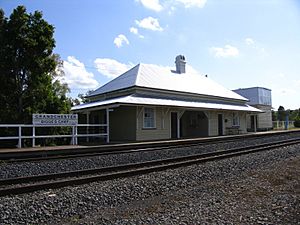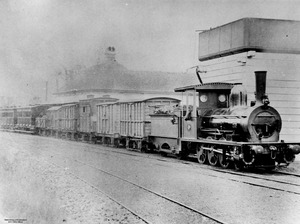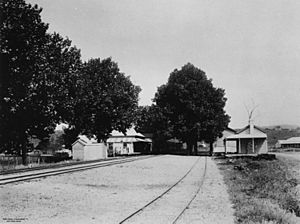Grandchester railway station facts for kids
Quick facts for kids Grandchester railway station |
|
|---|---|

Grandchester railway station, 2006
|
|
| Location | Ipswich Road, Grandchester, City of Ipswich, Queensland, Australia |
| Design period | 1870s - 1890s (late 19th century) |
| Built | 1875 - 1876 |
| Official name: Grandchester Railway Complex, Bigge's Camp | |
| Type | state heritage (built) |
| Designated | 21 October 1992 |
| Reference no. | 600729 |
| Significant period | 1875-1960s (historical) |
| Significant components | residential accommodation - station master's house/quarters, tower - water, chimney/chimney stack, pump house, office/s, waiting room, shed - storage, tank - water, views to, memorial - honour board/ roll of honour, platform, railway station, well, machinery/plant/equipment - transport - rail, signals |
| Lua error in Module:Location_map at line 420: attempt to index field 'wikibase' (a nil value). | |
The Grandchester railway station is a very old and important train station located in Grandchester, Queensland, Australia. It's special because it was part of Queensland's very first railway line! Built between 1875 and 1876, it's also known as Bigge's Camp. Today, it's recognized as a heritage site, meaning it's protected because of its historical value. It was added to the Queensland Heritage Register on October 21, 1992.
Contents
A Look Back: Grandchester's Railway Story
Grandchester, once called Bigge's Camp, holds a special place in Queensland's history. It was the end point for the very first railway line in Queensland. This line opened on July 31, 1865, connecting Ipswich to Grandchester. It was also the first part of the main railway line that would eventually go all the way to Toowoomba.
Early Construction and Changes
The station building itself saw important work done in 1875 and 1876. A goods shed, used for storing items transported by train, was also built during this time. In 1878, T. Neville signed a contract to do more work on the station buildings.
In 1876, a large water tank was moved to Grandchester from Laidley. This tank was important for supplying water to the steam trains. From 1885, a special locomotive (train engine) was kept here. Its job was to help push trains over the Little Liverpool Range, a hilly area. An engine shed was built in 1885 to house this locomotive. Another goods shed was also built that year.
Station Life Through the Years
The station master's house, where the person in charge of the station lived, was built in 1910. Around the same time, the main station building also had some changes. By 1961, the railway complex was quite busy. It included the station building with a signal cabin, two water tanks, a cream shed (for dairy products), a toilet, a pumphouse, the station master's house, and even yards for cattle.
However, things changed over time. The engine shed was taken down by 1963. The cattle yards were no longer used after 1991.
Grandchester Today
Today, the station buildings are looked after by the Queensland branch of the National Trust of Australia. This organization works to protect important historical places. The station is now open to the public once a month. Volunteers are there to give guided tours and share its fascinating history.
Exploring the Station: What You Can See
Grandchester railway station is located in a mostly rural area, near a bend in the Western Creek. The main station building sits on a timber platform. It has a unique design with a hipped roof (a roof that slopes down on all four sides). It also has a verandah (an open porch) all around it. This verandah is supported by posts and brackets.
Inside the Station Building
You'll notice a tall, central chimney stack with arched covers on top. The outside walls of the building have a special rough finish called rustication. The windows are double-hung and have decorative bars.
Even though the inside has changed a lot over the years, you can still see hints of its original layout. It used to have two bedrooms, a living room, a waiting room, and an office. Look up, and you might see the original timber ceilings and decorative cornices (molding where the wall meets the ceiling). Inside, there's also a special "roll of honour board," which was painted by Hugh F. O'Brien from Toowoomba.
Signals and Water
At one end of the building, there's a signal cabin. This cabin used to control the railway signals with a large 22-lever machine. It was taken out of service around 1988 when a new system called centralized traffic control (CTC) was introduced.
You'll also see a large, two-tier cast iron water tank. This tank was likely changed from a single-tier tank at some point. There's a dam nearby that probably supplied water to the tank. You can also find a brick well and a pumphouse, which would have helped move the water.
The Station Master's House
The station master's house is a typical elevated house for its time. It has a pyramidal roof (a roof that slopes up to a single point) and a verandah all around it. The design of the verandah posts might be special, but the overall style of the house was common back then.
Why Grandchester Station is Important
Grandchester Railway Complex was officially listed on the Queensland Heritage Register on October 21, 1992. This means it's recognized as a very important historical site for several reasons.
A Key Part of Queensland's History
The Grandchester Railway complex is historically important because it was the western end of Queensland's very first railway. This railway opened on July 31, 1865. Grandchester is widely known as a significant historical railway site for the entire state. It was also the first railway station in Queensland built using local materials.
A Rare Example
It's quite rare to find a station building that still includes living quarters, like the one at Grandchester. Other examples are very few, such as those at Clifton, Springsure, and Pentland.
Showing How Early Railways Looked
The station building and the water tank are key features that show how old this site is. They are believed to have been here since the mid-to-late 1870s. This makes them older than most other railway buildings in Queensland. Only a few others, like those at Gracemere, Murphys Creek, Nobby, and Clifton, might be as old or older.



